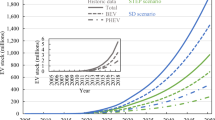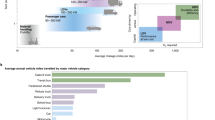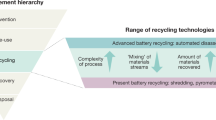Abstract
Today’s electric vehicles are almost exclusively powered by lithium-ion batteries, but there is a long way to go before electric vehicles become dominant in the global automotive market. In addition to policy support, widespread deployment of electric vehicles requires high-performance and low-cost energy storage technologies, including not only batteries but also alternative electrochemical devices. Here, we provide a comprehensive evaluation of various batteries and hydrogen fuel cells that have the greatest potential to succeed in commercial applications. Three sectors that are not well served by current lithium-ion-powered electric vehicles, namely the long-range, low-cost and high-utilization transportation markets, are discussed. The technological properties that must be improved to fully enable these electric vehicle markets include specific energy, cost, safety and power grid compatibility. Six energy storage and conversion technologies that possess varying combinations of these improved characteristics are compared and separately evaluated for each market. The remainder of the Review briefly discusses the technological status of these clean energy technologies, emphasizing barriers that must be overcome.
This is a preview of subscription content, access via your institution
Access options
Access Nature and 54 other Nature Portfolio journals
Get Nature+, our best-value online-access subscription
$29.99 / 30 days
cancel any time
Subscribe to this journal
Receive 12 digital issues and online access to articles
$119.00 per year
only $9.92 per issue
Buy this article
- Purchase on Springer Link
- Instant access to full article PDF
Prices may be subject to local taxes which are calculated during checkout








Similar content being viewed by others
References
Guarnieri, M. Looking back to electric cars. In 2012 Third IEEE History of Electro-technology Conf. (HISTELCON) 1–6 (2012); https://doi.org/10.1109/HISTELCON.2012.6487583
Global Plug-in Sales for 2016 (EV-Volumes, accessed 3 August 2017); http://www.ev-volumes.com/news/global-plug-in-sales-for-2016/
Energy Technology Perspectives 2017 (IEA, 2017); http://www.iea.org/etp2017/
Castle, S. Britain to ban new diesel and gas cars by 2040. The New York Times (2017); https://www.nytimes.com/2017/07/26/world/europe/uk-diesel-petrol-emissions.html
Hocking, M., Kan, J., Young, P., Terry, C. & Begleiter, D. Welcome to the Lithium-ion Age. (Deutsche Bank Markets Research, 2016); http://www.belmontresources.com/LithiumReport.pdf
Placke, T., Kloepsch, R., Dühnen, S. & Winter, M. Lithium ion, lithium metal, and alternative rechargeable battery technologies: the odyssey for high energy density. J. Solid State Electrochem. 21, 1939–1964 (2017).
Saxena, S., MacDonald, J. & Moura, S. Charging ahead on the transition to electric vehicles with standard 120 V wall outlets. Appl. Energy 157, 720–728 (2015).
Nykvist, B. & Nilsson, M. Rapidly falling costs of battery packs for electric vehicles. Nat. Clim. Change 5, 329–332 (2015).
Schmidt, O., Hawkes, A., Gambhir, A. & Staffell, I. The future cost of electrical energy storage based on experience rates. Nat. Energy 6, 17110 (2017).
Curry, C. Lithium-ion battery costs: squeezed margins and new business models. Bloomberg New Energy Finance (accessed 14 July 2017); https://about.bnef.com/blog/lithium-ion-battery-costs-squeezed-margins-new-business-models/
Knupfer, S. M. et al. Electrifying Insights: How Automakers Can Drive Electrified Vehicle Sales and Profitability (McKinsey & Company, 2017); http://go.nature.com/2HsQLmP
Sierzchula, W., Bakker, S., Maat, K. & van Wee, B. The influence of financial incentives and other socio-economic factors on electric vehicle adoption. Energy Policy 68, 183–194 (2014).
Global EV Outlook 2017: Two Million and Counting (IEA, 2017); https://www.iea.org/publications/freepublications/publication/global-ev-outlook-2017.html
Singer, M. Consumer Views on Plug-in Electric Vehicles—National Benchmark Report 2nd edn (NREL, 2016); http://www.nrel.gov/docs/fy17osti/67107.pdf
Li, W., Long, R., Chen, H. & Geng, J. A review of factors influencing consumer intentions to adopt battery electric vehicles. Renew. Sustain. Energy Rev. 78, 318–328 (2017).
Dimitropoulos, A., Rietveld, P. & van Ommeren, J. N. Consumer valuation of changes in driving range: a meta-analysis. Transp. Res. Part Policy Pract. 55, 27–45 (2013). This paper is a meta-analysis of studies investigating consumers’ willingness to pay for higher driving ranges for electric vehicles.
Kenworthy, J. R. & Laube, F. B. Patterns of automobile dependence in cities: an international overview of key physical and economic dimensions with some implications for urban policy. Transp. Res. Part Policy Pract. 33, 691–723 (1999).
Liebreich, M. Bloomerberg New Energy Finance London Summit 2017: Breaking Clean (2017); https://data.bloomberglp.com/bnef/sites/14/2017/09/BNEF-Summit-London-2017-Michael-Liebreich-State-of-the-Industry.pdf
Dahn, J. & Ehrlich, G. M. in Linden’s Handbook of Batteries 4th edn (ed. Reddy, T. B.) Ch. 26 (McGraw Hill, New York, 2011).
Andre, D. et al. Future generations of cathode materials: an automotive industry perspective. J. Mater. Chem. A 3, 6709–6732 (2015).
Hagen, M. et al. Lithium–sulfur cells: the gap between the state-of-the-art and the requirements for high energy battery cells. Adv. Energy Mater. 5, 1401986 (2015). This paper, along with refs 22, 51 and 52, evaluates the practically achievable specific energy and energy density of lithium–sulfur batteries.
Gröger, O., Gasteiger, H. A. & Suchsland, J.-P. Review—Electromobility: batteries or fuel cells? J. Electrochem. Soc. 162, A2605–A2622 (2015).
Kerman, K., Luntz, A., Viswanathan, V., Chiang, Y.-M. & Chen, Z. Review—practical challenges hindering the development of solid state Li ion batteries. J. Electrochem. Soc. 164, A1731–A1744 (2017). This paper summarizes the reported efforts and challenges in developing solid-state lithium-ion battery cells.
Fulton, L., Jenn, A. & Tal, G. GFEI Working Paper 16: Can We Reach 100 Million Electric Cars Worldwide by 2030? A Modelling/Scenario Analysis (Global Fuel Economy Initiative, 2017); https://www.globalfueleconomy.org/data-and-research/publications/gfei-working-paper-16
McFadden, D. Conditional Logit Analysis of Qualitative Choice Behavior (1973); https://elsa.berkeley.edu/reprints/mcfadden/zarembka.pdf
Chinese-made electric cars. ChinaAutoWeb (accessed 31 July 2017); http://chinaautoweb.com/electric-cars/
The Future of Trucks: Implications for Energy and the Environment (IEA, 2017); https://www.iea.org/publications/freepublications/publication/the-future-of-trucks---implications-for-energy-and-the-environment.html
Li, J.-Q. Battery-electric transit bus developments and operations: a review. Int. J. Sustain. Transp. 10, 157–169 (2016).
Ye, Y., Saw, L. H., Shi, Y., Somasundaram, K. & Tay, A. A. O. Effect of thermal contact resistances on fast charging of large format lithium ion batteries. Electrochim. Acta 134, 327–337 (2014).
Liu, Q. et al. Understanding undesirable anode lithium plating issues in lithium-ion batteries. RSC Adv. 6, 88683–88700 (2016).
Gao, Y. et al. Lithium-ion battery aging mechanisms and life model under different charging stresses. J. Power Sources 356, 103–114 (2017).
Akhavan-Rezai, E., Shaaban, M. F., El-Saadany, E. F. & Zidan, A. Uncoordinated charging impacts of electric vehicles on electric distribution grids: normal and fast charging comparison. In 2012 IEEE Power and Energy Society General Meeting 1–7 (2012); https://doi.org/10.1109/PESGM.2012.6345583
Dharmakeerthi, C. H., Mithulananthan, N. & Saha, T. K. Impact of electric vehicle fast charging on power system voltage stability. Int. J. Electr. Power Energy Syst. 57, 241–249 (2014).
Liu, P., Ross, R. & Newman, A. Long-range, low-cost electric vehicles enabled by robust energy storage. MRS Energy & Sustain. Rev. J. 2, E12 (2015). This paper discusses the use of aqueous batteries with inherently safe chemistries to enable long-range and low-cost electric vehicles.
Sripad, S. & Viswanathan, V. Performance metrics required of next-generation batteries to make a practical electric semi truck. ACS Energy Lett. 2, 1669–1673 (2017).
Yamaguchi, Y. in Encyclopedia of Applied Electrochemistry (eds Kreysa, G., Ota, K. & Savinell, R. F.) 1161–1165 (Springer, New York, 2014); https://doi.org/10.1007/978-1-4419-6996-5_144
Liu, W., Chen, L. & Tian, J. Uncovering the evolution of lead in-use stocks in lead-acid batteries and the impact on future lead metabolism in China. Environ. Sci. Technol. 50, 5412–5419 (2016).
Jung, J., Zhang, L. & Zhang, J. Lead–Acid Battery Technologies: Fundamentals, Materials, and Applications (CRC, Boca Raton, 2015).
Weinert, J. X., Burke, A. F. & Wei, X. Lead–acid and lithium-ion batteries for the Chinese electric bike market and implications on future technology advancement. J. Power Sources 172, 938–945 (2007).
Salkind, A. & Zguris, G. Lead-Acid Batteries. in Linden’s Handbook of Batteries 4th edn (ed. Reddy, T. B.) Ch. 16 (McGraw Hill, New York, 2011).
Moseley, P. T., Rand, D. A. J. & Peters, K. Enhancing the performance of lead–acid batteries with carbon—in pursuit of an understanding. J. Power Sources 295, 268–274 (2015). This paper, along with refs 42 and 43, reviews the performance of lead–carbon batteries and their power-assisting applications in hybrid electric vehicles.
Yang, J. et al. Review on the research of failure modes and mechanism for lead–acid batteries. Int. J. Energy Res. 41, 336–352 (2017).
Karden, E., Ploumen, S., Fricke, B., Miller, T. & Snyder, K. Energy storage devices for future hybrid electric vehicles. J. Power Sources 168, 2–11 (2007).
Jaiswal, A. & Chalasani, S. C. The role of carbon in the negative plate of the lead–acid battery. J. Energy Storage 1, 15–21 (2015).
The Advanced Lead–Acid Battery Consortium. Lead–Carbon Batteries to Boost Market Prospects of 48V Hybrids—ALABC (accessed 28 August 2017); http://www.alabc.org/press-releases/lead-carbon-batteries-to-boost-market-prospects-of-48v-hybrids
Fetcenko, M. & Koch, J. in Linden’s Handbook of Batteries 4th edn (ed. Reddy, T. B.) Ch. 22 (McGraw Hill, New York, 2011).
Manthiram, A., Fu, Y., Chung, S.-H., Zu, C. & Su, Y.-S. Rechargeable Lithium–Sulfur Batteries. Chem. Rev. 114, 11751–11787 (2014). This paper, along with refs 48–51, reviews the progress and challenges in improving the cycle life of lithium–sulfur batteries.
Eroglu, D., Zavadil, K. R. & Gallagher, K. G. Critical link between materials chemistry and cell-level design for high energy density and low cost lithium-sulfur transportation battery. J. Electrochem. Soc. 162, A982–A990 (2015).
Yin, Y.-X., Xin, S., Guo, Y.-G. & Wan, L.-J. Lithium–sulfur batteries: electrochemistry, materials, and prospects. Angew. Chem. Int. Ed. 52, 13186–13200 (2013).
Cheng, X.-B., Huang, J.-Q. & Zhang, Q. Review—Li metal anode in working lithium–sulfur batteries. J. Electrochem. Soc. 165, A6058–A6072 (2018).
Pope, M. A. & Aksay, I. A. Structural design of cathodes for Li–S batteries. Adv. Energy Mater. 5, 1500124 (2015).
Bonnick, P., Nagai, E. & Muldoon, J. Perspective—lithium–sulfur batteries. J. Electrochem. Soc. 165, A6005–A6007 (2018).
Liu, Q.-C. et al. A Flexible and wearable lithium–oxygen battery with record energy density achieved by the interlaced architecture inspired by bamboo slips. Adv. Mater. 28, 8413–8418 (2016).
Mizuno, F., Nakanishi, S., Kotani, Y., Yokoishi, S. & Iba, H. Rechargeable Li–air batteries with carbonate-based liquid electrolytes. Electrochemistry 78, 403–405 (2010).
Luntz, A. C. & McCloskey, B. D. Nonaqueous Li–air batteries: a status report. Chem. Rev. 114, 11721–11750 (2014). This paper, along with refs 56–58, reviews the progress and challenges in improving the cycle life and practical energy density of lithium–air batteries.
Manthiram, A. & Li, L. Hybrid and aqueous lithium–air batteries. Adv. Energy Mater. 5 (2015).
Christensen, J. et al. A critical review of Li/air batteries. J. Electrochem. Soc. 159, R1–R30 (2012).
Gallagher, G. K. et al. Quantifying the promise of lithium–air batteries for electric vehicles. Energy Environ. Sci. 7, 1555–1563 (2014).
Fu, J. et al. Electrically rechargeable zinc–air batteries: progress, challenges, and perspectives. Adv. Mater. 29, 1604685 (2017). This paper, along with refs 60, 67 and 68, reviews the progress and challenges in improving the durability and energy efficiency of zinc–air batteries.
Li, Y. & Lu, J. Metal–air batteries: will they be the future electrochemical energy storage device of choice? ACS Energy Lett. 2, 1370–1377 (2017).
Blurton, K. F. & Sammells, A. F. Metal/air batteries: their status and potential—a review. J. Power Sources 4, 263–279 (1979).
Atwater, T. B. & Dobley, A. in Linden’s Handbook of Batteries 4th edn (ed. Reddy, T. B.) Ch. 33 (McGraw Hill, New York, 2011)
Eckl, R., Burda, P., Foerg, A., Finke, H. & Lienkamp, P. D.-I. M. Alternative range extender for electric cars – zinc air batteries. In Conf. Future Automotive Technology (ed. Lienkamp, M.) 3–18 (Springer Fachmedien, Wiesbaden, 2013); https://doi.org/10.1007/978-3-658-01141-3_1
Bockstette, J., Habermann, K., Ogrzewalla, J., Pischinger, M. & Seibert, D. Performance plus range: combined battery concept for plug-in hybrid vehicles. SAE Int. J. Altern. Powertrains 2, 156–171 (2013).
Sieminski, D. Recent advances in rechargeable zinc-air battery technology. in Twelfth Annual Battery Conf. Applications and Advances 171–180 (1997); https://doi.org/10.1109/BCAA.1997.574099
Larsson, F., Rytinki, A., Ahmed, I., Albinsson, I. & Mellander, B.-E. Overcurrent abuse of primary prismatic zinc–air battery cells studying air supply effects on performance and safety shut-down. Batteries 3, 1 (2017).
Lee, D. U. et al. Recent progress and perspectives on bi-functional oxygen electrocatalysts for advanced rechargeable metal–air batteries. J. Mater. Chem. A 4, 7107–7134 (2016).
Mainar, A. R., Colmenares, L. C., Blázquez, J. A. & Urdampilleta, I. A brief overview of secondary zinc anode development: the key of improving zinc-based energy storage systems. Int. J. Energy Res. 42, 903–918 (2017).
Price, S. W. T. et al. The fabrication of a bifunctional oxygen electrode without carbon components for alkaline secondary batteries. J. Power Sources 259, 43–49 (2014).
Ross, P. N. & Sokol, H. The corrosion of carbon black anodes in alkaline electrolyte I. Acetylene black and the effect of cobalt catalyzation. J. Electrochem. Soc. 131, 1742–1750 (1984).
Cheiky, M. C. (Dreisbach Electromotive, Inc.) Air manager system for metal–air battery. US patent 5,571,630 (1996); http://www.google.com/patents/US5571630
Goldstein, J. R., Harats, Y., Sharon, Y. & Naimer, N. (Electric Fuel Ltd.) Scrubber system for removing carbon dioxide from a metal-air or fuel cell battery. US patent 5595,949 (1997); http://www.google.com/patents/US5595949
Pivovar, B. H 2 at Scale: Deeply Decarbonizing Our Energy System (NREL, 2016); http://www.nrel.gov/docs/fy16osti/66246.pdf
Technology Roadmap: Hydrogen and Fuel Cells (IEA, 2017); http://www.iea.org/publications/freepublications/publication/TechnologyRoadmapHydrogenandFuelCells.pdf
Pontes, J. Fuel Cells 2016; http://ev-sales.blogspot.com/2017/02/fuel-cells-2016.html
Toyota Mirai US car sales figures (accessed 8 August 2017); http://carsalesbase.com/us-car-sales-data/toyota/toyota-mirai/
Guerrero Moreno, N., Cisneros Molina, M., Gervasio, D. & Pérez Robles, J. F. Approaches to polymer electrolyte membrane fuel cells (PEMFCs) and their cost. Renew. Sustain. Energy Rev. 52, 897–906 (2015).
Wei, M., Smith, S. J. & Sohn, M. D. Experience curve development and cost reduction disaggregation for fuel cell markets in Japan and the US. Appl. Energy 191, 346–357 (2017).
Miotti, M., Hofer, J. & Bauer, C. Integrated environmental and economic assessment of current and future fuel cell vehicles. Int. J. Life Cycle Assess. 22, 94–110 (2017).
Kongkanand, A. & Mathias, M. F. The priority and challenge of high-power performance of low-platinum proton-exchange membrane fuel cells. J. Phys. Chem. Lett. 7, 1127–1137 (2016). This paper, along with refs 81–83, reviews the progress and challenges in reducing the cost and improving the lifetime of hydrogen fuel cells.
Wang, J. Barriers of scaling-up fuel cells: cost, durability and reliability. Energy 80, 509–521 (2015).
Banham, D. et al. A review of the stability and durability of non-precious metal catalysts for the oxygen reduction reaction in proton exchange membrane fuel cells. J. Power Sources 285, 334–348 (2015).
Banham, D. et al. New insights into non-precious metal catalyst layer designs for proton exchange membrane fuel cells: improving performance and stability. J. Power Sources 344, 39–45 (2017).
Wagner, F. T., Lakshmanan, B. & Mathias, M. F. Electrochemistry and the future of the automobile. J. Phys. Chem. Lett. 1, 2204–2219 (2010).
Mercedes-Benz GLC F-CELL in 2017 will be plug-in FCEV. Fuel Cells Bull. 2016, 12 (2016).
Vinsnic, B. Nikola CEO: Fuel-cell class 8 truck on track for 2021 (SAE International, accessed 20 November 2017); http://articles.sae.org/15616/
Alazemi, J. & Andrews, J. Automotive hydrogen fuelling stations: an international review. Renew. Sustain. Energy Rev. 48, 483–499 (2015). This paper, along with ref. 74, reviews international deployments and future development of hydrogen production and fuelling infrastructure.
Melaina, M. & Penev, M. Hydrogen Station Cost Estimates: Comparing Hydrogen Station Cost Calculator Results with Other Recent Estimates (NREL, 2013); https://pdfs.semanticscholar.org/a677/6ff7178ccc80060ebaf945c277c46aaf4dab.pdf
Qin, N., Brooker, P. & Srinivasan, S. Hydrogen Fueling Stations Infrastructure (2014); http://fsec.ucf.edu/en/publications/pdf/fsec-cr-1986-14.pdf
Schroeder, A. & Traber, T. The economics of fast charging infrastructure for electric vehicles. Energy Policy 43, 136–144 (2012).
Lajunen, A. & Lipman, T. Lifecycle cost assessment and carbon dioxide emissions of diesel, natural gas, hybrid electric, fuel cell hybrid and electric transit buses. Energy 106, 329–342 (2016).
Kalamaras, C. M. & Efstathiou, A. M. Hydrogen production technologies: current state and future developments. In Conference Papers in Science, 690627 (Hindawi Publishing Corporation, Limassol, 2013).
Ramachandran, S. & Stimming, U. Well to wheel analysis of low carbon alternatives for road traffic. Energy Environ. Sci. 8, 3313–3324 (2015).
Staffell, I. & Dodds, P. The role of hydrogen and fuel cells in future energy systems. (H2FC SUPERGEN, 2017); http://www.h2fcsupergen.com/wp-content/uploads/2015/08/J5212_H2FC_Supergen_Energy_Systems_WEB.pdf
Zihrul, P. et al. Voltage cycling induced losses in electrochemically active surface area and in H2/air-performance of PEM fuel cells. J. Electrochem. Soc. 163, F492–F498 (2016).
Hua, T. et al. Status of hydrogen fuel cell electric buses worldwide. J. Power Sources 269, 975–993 (2014).
Ballard Powered Fuel Cell Electric Bus Achieves 25,000 Hours of Revenue Operation (Ballard Power Systems, accessed 8 September 2017); http://www.ballard.com/modules-display/news-releases/2017/08/29/ballard-powered-fuel-cell-electric-bus-achieves-25-000-hours-of-revenue-operation
AC Transit’s Fuel Cell Program Breaks 25,000 Hour Operating Record (AC Transit, accessed 23 November 2017); http://www.actransit.org/2017/07/11/fuel-cell-record-25k/
Eudy, L., Post, M. & Jeffers, M. Fuel Cell Buses in US Transit Fleets: Current Status 2016 (NREL, 2016); https://energy.gov/sites/prod/files/2016/12/f34/fcto_2016_fuel_cell_bus_report.pdf
Kurtz, J., Sprik, S., Ainscough, C. & Saur, G. Fuel Cell Electric Vehicle Evaluation (2017); https://www.hydrogen.energy.gov/pdfs/review17/tv001_kurtz_2017_o.pdf
Acknowledgements
We thank the Natural Sciences and Engineering Research Council of Canada for financial support. We also thank S. Knights and C. Reid (Ballard) for their feedback and comments.
Author information
Authors and Affiliations
Corresponding author
Ethics declarations
Competing interests
Z.C. has patents filed involving lead-carbon batteries (US 62/606,602), lithium-based batteries (US 15/548,549) and zinc-air batteries (US 15/555,668), and patents published or issued involving metal–air batteries (US 15/106,222, US 9,590,253, US 9,419,287). D.B. and S.Y. are employed by Ballard Power Systems, Inc., a provider of clean energy and fuel-cell solutions. A.H. works in the group research unit of Daimler AG, where he is involved in hydrogen fuel-cell and lithium–ion, metal–sulfur and solid-state battery projects.
Additional information
Publisher’s note: Springer Nature remains neutral with regard to jurisdictional claims in published maps and institutional affiliations.
Supplementary information
Supplementary Information
Supplementary Tables 1–3.
Rights and permissions
About this article
Cite this article
Cano, Z.P., Banham, D., Ye, S. et al. Batteries and fuel cells for emerging electric vehicle markets. Nat Energy 3, 279–289 (2018). https://doi.org/10.1038/s41560-018-0108-1
Received:
Accepted:
Published:
Issue Date:
DOI: https://doi.org/10.1038/s41560-018-0108-1
This article is cited by
-
A cross-scale framework for evaluating flexibility values of battery and fuel cell electric vehicles
Nature Communications (2024)
-
Effect of pre-intercalation on Li-ion diffusion mapped by topochemical single-crystal transformation and operando investigation
Nature Materials (2024)
-
Exploration of the two-dimensional transition metal phosphide MoP2 as anode for Na/K ion batteries
npj 2D Materials and Applications (2024)
-
Solvation-property relationship of lithium-sulphur battery electrolytes
Nature Communications (2024)
-
“Polymer in ceramic” type LLZTO/PEO/PVDF composite electrolyte with high lithium migration number for solid-state lithium batteries
Ionics (2024)



